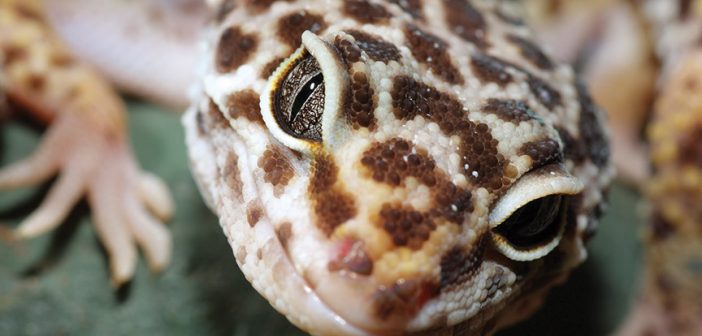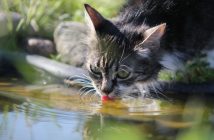by Neil Moss, DVM
I love these cute little geckos and consider them the best starter reptile if you want to begin your adventure as a herpetologist. One of the secrets to successfully keeping reptiles is to mimic their natural environment as closely as possible, and it just so happens that Leopard Geckos come from the mountains of Afghanistan where the climate is very like that of Utah. Plus, they are nocturnal and so don’t need special UV lights. Being nocturnal makes them ideal for a child’s school schedule; when the child is at school, the gecko is sleeping and wakes up in the early evening when everyone’s home.
They thrive in dry desert conditions and at a temperature of 80° to 90° F. Avoid sand for bedding because it can lead to intestinal impactions, especially in juveniles which swallow a lot of substrate as they strike out at prey. In fact, I favor white paper towel, which is easily collected up when soiled and absorbs spilled water thus keeping the cage drier. Leopard Geckos have a chosen spot where they empty their bowels, which goes by the fancy name of the defaecatorium (a great Scrabble word), which is another reason their cages stay cleaner longer! I like to give them a cave to hide in during the day which, if placed against the front of the glass, can have a sheet of cardstock placed over it which can be lifted allowing the children to see their gecko.
They are strict insectivores and thrive off a diet of crickets and mealworms; for variety, they can occasionally have a wax worm but not too many because they are very fattening. The crickets must be gut loaded, which means they are fed on a veggie diet enriched with calcium and vitamins for 15 to 30 minutes before being offered to your gecko. A well fed, healthy gecko has a big, fat tail.
I see a variety of health problems most of which are manifested by a shrinking of the tail (known as stick tail):
• Sand impactions. As mentioned earlier, when geckos strike at their prey they will often ingest pieces of substrate which can collect in their intestines and cause blockages. This often happens in juveniles. Your vet can often diagnose these by back lighting the reptile. Sometimes these can be relieved by using a few drops of oil as a laxative.
• Missing toes! When they shed, the skin around the toes is often the last to lift. If the cage is too dry this skin shrinks and then cuts off the circulation to the toes which can then die and drop off. One tip to prevent this is to have a small cave inside the tank containing a little moist moss. When they shed, they can obtain some vital moisture by going inside and rubbing against the moist moss.
• Eye plugs. These are very hard to see and the first indication the owner gets is the perception that the gecko has gone blind. When I see them I can often pull out (from each eye) a very large plug of keratin that looks like a thick contact lens. No one is sure what causes these plugs, although a lack of Vitamin A in the diet has been suggested. I have tried supplementing this, but so far have not found a permanent cure for this condition. Once the plugs have been removed the gecko can see again! Eating commences and she gains weigh back in short order.
With gentle handling and common sense, these beautiful creatures can survive six to 10 years. Enjoy.
Dr. Neil Moss graduated from the Royal Veterinary College, London, and has worked in England; Newfoundland, Canada and Utah. Owner of the Kaysville Veterinary Hospital, he works with dogs, cats, exotic mammals, reptiles and birds. He is a former President of the Utah Veterinary Medical Association; Utah Veterinarian of the Year for 2012; serves on the Educational Commission for Foreign Veterinary Graduates and currently serves as the Utah delegate to the American Veterinary Medical Association.




